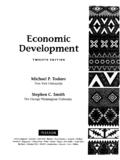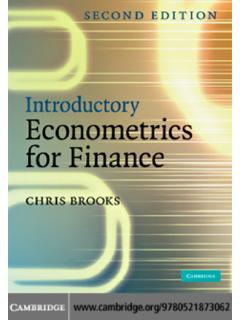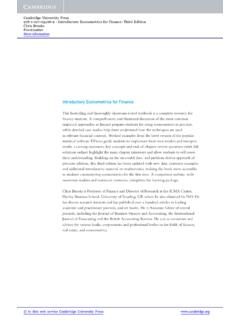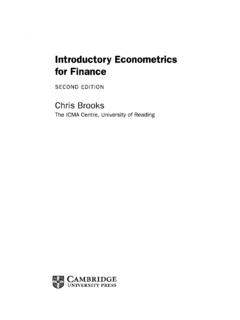Transcription of Introductory Econometrics for Finance THIRD EDITION Chris ...
1 Introductory Econometrics for Finance THIRD EDITION Chris Brooks The ICMA Centre, Henley Business School, Uriiversity of Reading CAMBRIDGE UNIVERSITY PRESS Introductory Econometrics for Finance THIRD EDITION Chris Brooks The ICMA Centre, Henley Business School, University of Reading CAMBRIDGE UNIVERSITY PRESS Contents List of figures page xii List of tables xv List of boxes xvii List of Screenshots xix Preface to the THIRD EDITION xxi Acknowledgements xxv 1 Introduction 1 What is Econometrics ? 2 Is financial Econometrics different from 'economic Econometrics '? 2 Types of data 4 Returns in financial modelling 7 Steps involved in formulating an econometric model 11 Points to consider when reading articles in empirical Finance 12 A note on Bayesian versus classical statistics 13 An introduction to EViews 14 Further reading 24 Outline of the remainder of this book 24 2 Mathematical and Statistical foundations 28 Functions 28 Differential calculus 37 Matrices 41 Probability and probability distributions 56 Descriptive statistics 61 3 A brief overview of the classical linear regression model 75 What is a regression model?
2 75 Regression versus correlation 76 Simple regression 76 Some further terminology 84 Simple linear regression in EViews - estimation of an optimal hedge ratio 86 vi Contents The assumptions underlying the classical linear regression model 90 Properties of the OLS estimator 91 Precision and Standard errors 93 An introduction to Statistical inference 98 A special type of hypothesis test: the (-ratio 111 An example of a simple f-test of a theory in Finance : can US mutual funds beat the market? 113 Can UK unit trust managers beat the market? 115 The overreaction hypothesis and the UK stock market 116 The exact significance level 120 Hypothesis testing in EViews - example 1: hedging revisited 121 Hypothesis testing in EViews example 2: the CAPM 123 Appendix: Mathematical derivations ofCLRM results 127 4 Further development and analysis of the classical linear regression model 134 Generalising the simple model to multiple linear regression 134 The constant term 135 How are the parameters (the elements of the vector) calculated in the generalised case?)
3 137 Testing multiple hypotheses: the F-test 139 Sample EViews output for multiple hypothesis tests 144 Multiple regression in EViews using an APT-style model 145 Data mining and the true size of the test 150 Goodness of fit statistics 151 Hedonic pricing models 156 Tests of non-nested hypotheses 159 Quantile regression 161 Appendix : Mathematical derivations of CLRM results 168 Appendix : A brief introduction to factor models and principal components analysis 170 5 Classical linear regression model assumptions and diagnostic tests 179 Introduction 179 Statistical distributions for diagnostic tests 180 Assumption 1: E(ut) = 0 181 Assumption 2: var( () = a2 < oo 181 Assumption 3: cov(w,, Uj) = 0 for i j 188 Assumption 4: the x, are non-stochastic 208 Assumption 5: the disturbances are normally distributed 209 Multicollinearity 217 Adopting the wrong functional form 220 Omission of an important variable 224 Inclusion of an irrelevant variable 225 Contents * vii Parameter stability tests 226 Measurement errors 235 A strategy for constructing econometric models and a discussion of model-building philosophies 238 Determinants of sovereign credit ratings 240 6 Univariate time series modelling and forecasting 251 Introduction 251 Some notation and concepts 252 Moving average processes 256 Autoregressive processes 259 The partial autocorrelation function 266 ARMA processes 268 Building ARMA models.)
4 The Box-Jenkins approach 273 Constructing ARMA models in EViews 276 Examples of time series modelling in fmance 281 Exponential smoothing 283 Forecasting in Econometrics 285 Forecasting using ARMA models in EViews 296 Exponential smoothing models in EViews 299 7 Multivariate models 305 Motivations 305 Simultaneous equations bias 307 So how can simultaneous equations models be validly estimated? 308 Can the original coefFicients be retrieved from the TT s? 309 Simultaneous equations in Finance 311 A defmition of exogeneity 312 Triangul r systems 314 Estimation procedures for simultaneous equations systems 315 An application of a simultaneous equations approach to modelling bid-ask spreads and trading activity 318 Simultaneous equations modelling using EViews 323 Vector autoregressive models 326 Does the VAR include contemporaneous terms? 332 Block significance and causality tests 333 VARs with exogenous variables 335 Impulse responses and variance decompositions 336 VAR model example: the interaction between property returns and the macroeconomy 338 VAR estimation in EViews 344 8 Modelling long-run relationships in Finance Stationarity and unit root testing Tests for unit roots in the presence of structural breaks 353 353 365 369 373 375 376 377 380 386 390 391 398 400 415 415 420 420 421 421 422 423 428 431 439 440 440 441 441 443 445 446 452 454 461 463 464 466 467 471 Contents Testing for unit roots in EViews Cointegration Equilibrium correction or error correction models Testing for cointegration in regression.
5 A residuals-based approach Methods of parameter es tun ad on in cointegrated systems Lead lag and long-term relationships between spot and futures markets Testing for and estimating cointegrating systems using the Johansen technique based on VARs Purchasing power parity Cointegration between international bond markets Testing the expectations hypothesis of the term structure of interest rates Testing for cointegration and modelling cointegrated systems using EViews Modelling volatility and correlation Motivations: an excursion into non-linearity land Models for volatility Historical volatility Implied volatility models Exponentially weighted moving average models Autoregressive volatility models Autoregressive conditionally heteroscedastic (ARCH) models Generalised ARCH (GARCH) models Estimation of ARCH/GARCH models Extensions to the basic GARCH model Asymmetrie GARCH models The GJR model The EGARCH model GJR and EGARCH in EViews Tests for asymmetries in volatility GARCH-in-mean Uses of GARCH-type models including volatility forecasting Testing non-linear restrictions or testing hypotheses about non-linear models Volatility forecasting: some examples and results from the literature Stochastic volatility models revisited Forecasting covariances and correlations Covariance modelling and forecasting in fmance.
6 Some examples Simple covariance models Multivariate GARCH models Direct correlation models Contents ix Extensions to the basic multivariate GARCH model 472 A multivariate GARCH model for the CAPM with time-varying covariances 474 Estimating a time-varying hedge ratio for FTSE stock index returns 475 Multivariate stochastic volatility models 478 Estimating multivariate GARCH models using EViews 480 Appendix: Parameter estimation using maximum likelihood 484 10 Switching models 490 Motivations 490 Seasonalities in financial markets: introduction and literature review 492 Modelling seasonality in financial data 493 Estimating simple piecewise linear functions 500 Markov switching models 502 A Markov switching model for the real exchange rate 503 A Markov switching model for the gilt equity yield ratio 506 Estimating Markov switching models in EViews 510 Threshold autoregressive models 513 Estimation of threshold autoregressive models 515 Specification tests in the context of Markov switching and threshold autoregressive models: a cautionary note 516 A SETAR model for the French franc-German mark exchange rate 517 Threshold models and the dynamics of the FTSE 100 index and index futures markets 519 A note on regime switching models and forecasting accuracy 523 11 Panel data 526 Introduction - what are panel techniques and why are they used?
7 526 What panel techniques are available? 528 The fixed effects model 529 Time-fixed effects models 531 Investigating banking competition using a fixed effects model 532 The random effects model 536 Panel data application to credit stability of banks in Central and Eastern Europe 537 Panel data with EViews 541 Panel unit root and cointegration tests 547 Further reading 557 12 Limited dependent variable models 559 Introduction and motivation 559 The linear probability model 560 x * Contents The logit model 562 Using a logit to test the pecking order hypothesis 563 The probit model 565 Choosing between the logit and probit models 565 Estimation of limited dependent variable models 565 Goodness of fit measures for linear dependent variable models 567 Multinomial linear dependent variables 568 The pecking order hypothesis revisited the choice between fmancing methods 571 Ordered response linear dependent variables models 574 Are unsolicited credit ratings biased
8 Downwards? An ordered probit analysis 574 Censored and truncated dependent variables 579 Limited dependent variable models in EViews 583 Appendix: The maximum likelihood estimator for logit and probit models 589 13 Simulation methods 591 Motivations 591 Monte Carlo simulations 592 Variance reduction techniques 593 Bootstrapping 597 Random number generation 600 Disadvantages of the Simulation approach to econometric or financial problem solving 601 An example of Monte Carlo Simulation in econometric:: deriving a set of critical values for a Dickey F ller test 603 An example of how to simulate the price of a financial option 607 An example of bootstrapping to calculate capital risk requirements 613 14 Conducting empirical research or doing a project or dissertation in Finance 626 What is an empirical research project and what is it for? 626 Selecting the topic 627 Sponsored or independent research? 629 The research proposal 631 Working papers and literature on the internet 631 Getting the data 633 Choice of Computer Software 634 Methodology 634 Event studies 634 Tests of the CAPM and the Fama French Methodology 648 Contents * xi How might the finished project look?
9 661 Presentational issues 666 Appendix 1 Sources of data used in this book 667 Appendix2 Tables of Statistical distributions 668 Glossary 680 References 697 Index 710



















